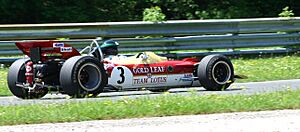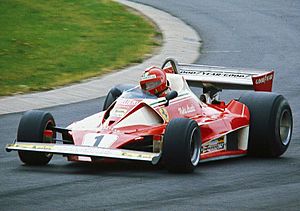History of Formula One facts for kids

Formula One racing started a long time ago, in the 1920s and 1930s, with European Grand Prix races. The modern Formula One began in 1946 when the FIA (a big sports group) made new rules. The first official World Championship for drivers happened in 1950.
The history of F1 is closely linked to how its car rules changed over time. Besides the main World Championship, there were also many non-championship F1 races. These stopped in 1983 because racing became too expensive. Some countries, like South Africa and the United Kingdom, even had their own F1 championships in the 1960s and 1970s.
Contents
- The Start of Formula One Racing
- Early Days and Post-War Engines (1946–1950)
- Italian and Mercedes Cars Dominate (1950–1957)
- British Teams and Rear-Mid Engine Revolution (1958–1961)
- British Drivers and 1.5-litre Engines (1962–1967)
- DFV Engine, Sponsorship, Safety, and Aerodynamics (1968–1976)
- Ground-Effect Era (1977–1982)
- 1.5-litre Turbo-Charged Engines (1983–1988)
- 3.5-litre Engines, Active Suspension, and Driver Aids (1989–1993)
- Focus on Safety and New Rules (1994)
- 3-litre Engines and Manufacturer Involvement (1995–1999)
- V10 Engines and Road Car Manufacturers (2000–2005)
- 2.4-litre V8 Engines (2006–2008)
- Cost-Cutting and Manufacturer Departures (2009–2013)
- 1.6-litre Turbocharged V6 Hybrid Engines (2014–2021)
- Ground Effect Cars and Aerodynamic Changes (2022–Present)
- How Car Quality and Driver Skill Matter (1950–2020)
- See also
The Start of Formula One Racing
Early Days and Post-War Engines (1946–1950)
Formula One was officially created in 1946 by the FIA. It was meant to be the top single-seater racing category in the world, starting in 1947. At first, it was called Formula A, Formula I, or Formula 1.
The early rules were based on engine size, similar to before World War II. Cars with 4.5-litre engines (without superchargers) could race against smaller 1.5-litre cars that had superchargers. Larger 3-litre supercharged cars were not allowed.
There's some debate about the very first F1 race. The 1946 Turin Grand Prix on September 1st was won by Achille Varzi in an Alfa Romeo 158 Alfetta. But this was before the rules were fully in place. The 1947 Pau Grand Prix, won by Nello Pagani in a Maserati 4CL, is often seen as the first definite F1 race.
Championships for drivers or teams didn't start right away. In the early years, about 20 races were held in Europe each year. Most of the best cars came from Italy, especially Maserati. Famous drivers like Alberto Ascari and Juan Manuel Fangio became stars during this time.
Italian and Mercedes Cars Dominate (1950–1957)
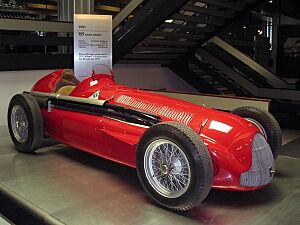
In 1950, the FIA launched the first official World Championship for Drivers. This championship included six major European races and the Indianapolis 500 in the USA. Italian teams like Alfa Romeo, Ferrari, and Maserati were very strong at the start.
Alfa Romeo completely dominated the 1950 season, winning almost every race with their pre-war "Alfetta" 158 cars. The only exception was the Indianapolis 500, which had different rules and was not usually raced by F1 teams. Nino Farina won the first championship. Juan Manuel Fangio won in 1951 with the Alfa-Romeo 159. These Alfa Romeo engines were very powerful but used a lot of fuel.
Enzo Ferrari realized that the 1.5-litre supercharged engines were not the future. For the last races of 1950, Ferrari brought out new 4.5-litre V12 engines that didn't use superchargers. These cars used much less fuel and were very competitive. Alfa Romeo, a state-owned company, stopped racing after 1951 because the Italian government wouldn't pay for a new car design.
With Alfa Romeo gone, Ferrari became almost unbeatable. The FIA had planned to change the rules in 1954 to 2.5-litre engines. Since no one wanted to build new cars for just two years, the World Championship races used Formula Two rules for 1952 and 1953. Ferrari continued to dominate with their lighter 4-cylinder cars, and Alberto Ascari won two championships in 1952 and 1953.
In 1954, the World Championship returned to Formula One rules with new 2.5-litre engines. This brought in more teams. Lancia and Mercedes-Benz joined, hiring top drivers like Ascari and Fangio. Mercedes cars were very advanced, with features like fuel injection. They started the 1954 season with Juan Manuel Fangio winning the first race.
Mercedes dominated the next two seasons with Fangio and Stirling Moss winning most races. However, Mercedes suddenly left F1 at the end of 1955. They had shown their technology was superior, but a terrible crash involving one of their sports cars at Le Mans that year, which killed many people, was a big reason for their departure.
After Mercedes left, Lancia also pulled out, giving their engines and cars to Ferrari. Fangio used the Lancia-designed Ferrari to win his fourth championship in 1956. Driving for Maserati, he won his fifth championship in 1957, a record that stood for 46 years. Ferrari developed a new V6 engine for 1957. In 1958, Mike Hawthorn became the first British F1 World Champion.
British Teams and Rear-Mid Engine Revolution (1958–1961)

In 1958, races became shorter, and cars had to use regular aviation fuel instead of special mixtures. A new award, the International Cup for F1 Manufacturers (Constructors' Championship), was introduced.
With Fangio retired, Mike Hawthorn in a Ferrari won the 1958 Drivers' Championship. The British Vanwall team won the first Constructors' Championship. Stirling Moss lost the drivers' title by just one point, partly because he helped Hawthorn avoid disqualification in one race. This season also saw the first woman, Maria Teresa de Filippis, race in Formula One.
A big change happened in 1958: Stirling Moss won the 1958 Argentine Grand Prix in a Cooper car with its engine placed behind the driver (mid-engined). This was the first time a mid-engined car won an F1 race. It was also the first win for a private team and for a car using an engine built by another company. The Cooper cars, though with smaller engines, started to show their potential.
By 1959, with new 2.5-litre engines, the small British Cooper cars began to dominate. The 1959 season saw a close fight between Jack Brabham (Cooper) and Stirling Moss (Rob Walker's Cooper). Brabham won the title.
In 1960, Enzo Ferrari famously said, "the horses pull the car rather than push it," meaning he preferred front-engined cars. But he was already secretly working on mid-engined F1 cars. The British mid-engined cars had much better handling than the front-engined Italian cars. Even with less power, their superior handling and less tyre wear made them faster. It became clear that mid-engined cars were the future. Lotus and BRM also introduced mid-engined cars. Brabham won his second title with Cooper.
By 1961, British teams like Lotus, Cooper, and BRM (and later McLaren, Tyrrell, and Williams) had taken over from big car manufacturers like Ferrari and Mercedes. These British teams, often called garagistes (garage teams) by Enzo Ferrari, built their chassis and bought engines from independent companies like Coventry-Climax. They proved that new ideas, not just big factories, could win races.
In 1961, F1 engine rules changed again, limiting engines to 1.5-litre without superchargers to reduce speeds. Ferrari, with its new 1.5-litre V6 engine in the 156, dominated the season. American Phil Hill won the 1961 title for Ferrari. Sadly, his teammate, Wolfgang von Trips, died in a crash at the Italian Grand Prix.
Throughout the 1950s and 1960s, many F1 races were held that were not part of the World Championship. These races still attracted top drivers and teams.
British Drivers and 1.5-litre Engines (1962–1967)
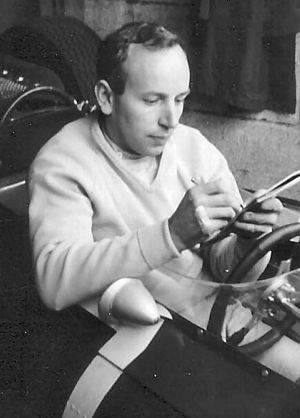
In 1962, the Lotus team introduced the Lotus 25 with a new V8 engine. This car had a special aluminum chassis called a monocoque, which was a huge step forward in technology. It was unreliable at first, and Graham Hill won the title for BRM.
Once the Lotus 25 became reliable, Jim Clark and Lotus began to dominate. Clark won two titles in three years, in 1963 and 1965. In 1965, he became the only driver to win both the F1 Championship and the Indianapolis 500 in the same year. In 1964, John Surtees won the title for Ferrari, becoming the only person to win world championships in both car and motorcycle racing. The last 1.5-litre F1 race in 1965 saw Richie Ginther give Honda its first F1 victory.
In 1966, F1 engines changed again, allowing 3.0-litre non-supercharged engines or 1.5-litre supercharged engines. This was a transition year for most teams. Jack Brabham's own racing team was the big winner. His light car with a reliable Repco V8 engine won the championship in 1966. In 1967, his teammate, Denny Hulme, won the title.
In 1967, Lotus introduced the Lotus 49 with the new Cosworth DFV V-8 engine. This engine would dominate F1 for the next ten years. The DFV was light, powerful, and designed to be a strong part of the car's structure. This allowed Lotus to build a very light chassis. The engine had some early problems, but it was a game-changer.
By the late 1960s, about a third of the F1 races were held outside Europe. British and English-speaking drivers were very successful in the 1960s. Drivers like Graham Hill, Jim Clark, John Surtees, Jackie Stewart, Jack Brabham, Denny Hulme, and Phil Hill won most of the championships.
DFV Engine, Sponsorship, Safety, and Aerodynamics (1968–1976)
In 1968, other teams could also use the powerful DFV engine. Ken Tyrrell's team, with Jackie Stewart driving a Matra car, became a new strong competitor. Sadly, Jim Clark died in a Formula Two race in April 1968.
The 1968 season saw three big changes: 1. Sponsorship: Teams started putting sponsor logos on their cars. Team Gunston was the first private team to do this, and then Team Lotus became the first factory team to use sponsor colors (Gold Leaf cigarettes). 2. Wings: Cars started using wings to create downforce (pushing the car down for more grip). Colin Chapman of Lotus introduced small wings. Other teams quickly added bigger, higher wings. These wings sometimes broke, leading to crashes. 3. Full-face helmets: Dan Gurney was the first driver to wear a full-face helmet, which offered much better protection.
Lotus won both titles in 1968 with Graham Hill. After Jim Clark's death, drivers pushed for more safety in racing. The FIA banned some advanced fuel tank designs for 1970. In 1969, the FIA also restricted the size and height of wings after several crashes.
Safety became a huge concern. The Belgian Grand Prix was even canceled because drivers refused to race on an unsafe track. Jackie Stewart easily won the 1969 title with the Matra MS80. This was a great achievement for a new team and the only F1 title won by a French-built car.
In 1970, Tyrrell decided to use the Cosworth engine instead of Matra's V12, ending their partnership. Lotus introduced the very innovative Lotus 72 car. It had problems at first, but once fixed, it was very fast. Lotus's new leader, Jochen Rindt, dominated the championship until he was killed in a crash at Monza. He won the 1970 title after his death. Slick tyres were also introduced by Goodyear in 1970.
After Rindt's death, Lotus had a difficult 1971 season. Tyrrell and Stewart easily won in 1971. In 1972, Lotus, with their black and gold John Player Special livery, surprised everyone. 25-year-old Brazilian driver Emerson Fittipaldi became the youngest world champion at the time.
In 1973, Fittipaldi and Ronnie Peterson (Lotus teammates) raced each other, while Stewart and François Cevert were strong for Tyrrell. Stewart won the Drivers' title. Sadly, at the final race in the USA, Cevert crashed and died during practice. Stewart then retired from racing.
McLaren became very strong in 1973. Their new M23 car, based on the Lotus 72, was excellent. Fittipaldi left Lotus to join McLaren.
The 1974 season was very close. McLaren and Fittipaldi won, but Ferrari, with young Niki Lauda and Clay Regazzoni, bounced back. Lauda's season ended after a crash. The championship was decided in the very last race between Fittipaldi, Regazzoni, and Jody Scheckter.
By this time, the designs of the Lotus 49 and 72 had changed how cars were built. In 1975, the Ferrari 312T appeared, with a special gearbox that improved weight distribution.
Ferrari won the Constructors' titles in 1975, 1976, and 1977. Lauda won his first Drivers' title easily in 1975. A small team called Hesketh won the Dutch Grand Prix with James Hunt. That year, Lella Lombardi also became the first woman to score points in F1.
In 1976, Fittipaldi made a surprising move to race for his brother's Brazilian team. James Hunt joined McLaren. Lauda's second title seemed certain until he had a terrible crash at the Nürburgring, suffering severe burns. Amazingly, he was back in his Ferrari six weeks later. He lost the championship by just one point to James Hunt in the final race in Japan, when Lauda decided to stop due to heavy rain, saying the risk was too high.
The most unusual car of 1976 was the 6-wheeled Tyrrell P34. It was a good car, even winning a race, but not better than the best 4-wheeled cars.
Lauda's relationship with Enzo Ferrari became difficult after the Fuji incident. Lauda left Ferrari before the end of the 1977 season, having already won his second title. The new Wolf team, with Jody Scheckter, finished second to Lauda that year.
Ground-Effect Era (1977–1982)
In 1977, two big technical changes came to F1. Lotus introduced the Lotus 78, which used "ground effect" for the first time. This meant the car's underside was shaped like a wing, creating huge downforce and making the car stick to the track better. The Lotus 78 won five races.
Renault also introduced the first 1.5-litre turbocharged engine in their RS01 car. Turbocharged engines had been allowed for 11 years, but no one had used them because of concerns about fuel use and "turbo lag" (a delay in power delivery). Renault, however, believed in this technology.
Renault's entry also brought Michelin's radial tyres to F1. Goodyear, who had a monopoly, had to quickly develop their own radial tyres to compete.
For 1978, the new Lotus 79 made even better use of ground effect. Many teams started trying this technology. Mario Andretti won the Championship in the "Black Beauty" Lotus 79. Brabham tried to create even more downforce with their "fan car," the BT46B. This car used a large fan to suck air from under the car. It won its only race with Niki Lauda before being withdrawn.
Later in 1978, Ronnie Peterson crashed at Monza and his Lotus caught fire. He died the next day from complications.
In 1979, teams like Ligier, Williams, and even Ferrari (despite their flat-12 engine making ground effect harder) built effective wing-cars. Renault continued with their turbo engine, which often broke down, earning it the nickname 'Little Yellow Teapot'. However, it finally won its first race in 1979.
The new technologies from Renault and Lotus led to a big fight in the early 1980s, known as the FISA–FOCA war. Turbo engines were powerful but expensive and difficult to develop. They also made it harder to design ground effect "tunnels" under the car. Teams with big manufacturers (like Renault and Ferrari) used turbos, while smaller teams relied on the cheaper, reliable Cosworth DFV engine and ground effect. This led to a political battle between the FIA (FISA) and the teams (FOCA), led by Bernie Ecclestone.
The battles between FISA and FOCA overshadowed the racing. Jody Scheckter won Ferrari's last title for 21 years in 1979. Alan Jones and Keke Rosberg won titles for Williams in 1980 and 1982. Nelson Piquet won for Brabham in 1981 and 1983.
Sadly, Patrick Depailler died in 1980. In 1982, Ferrari suffered a double blow with the death of Gilles Villeneuve and a serious injury to his teammate Didier Pironi. These tragedies helped both sides in the FISA-FOCA dispute to resolve their differences for the good of the sport.
In 1981, McLaren introduced the first carbon fiber chassis. This made cars much lighter and stiffer, improving grip and cornering speed. Many people were unsure about its safety, but John Watson's 1981 crash proved it was very safe, as he walked away unharmed from a violent accident. By the mid-1980s, all teams used carbon fiber chassis.
1.5-litre Turbo-Charged Engines (1983–1988)
The 1983 title, won by Piquet for the BMW-powered Brabham team, was the first ever won by a turbocharged engine. By 1983, it was clear that turbocharged engines were the future for F1. They were faster on almost all tracks. By 1984, only Tyrrell still used the old DFV engines.
By 1986, some turbo engines were producing over 1350 horsepower in qualifying. This was an incredible amount of power. To control speeds, fuel consumption and turbo boost pressure were limited. By 1988, turbos were only slightly more powerful than the new 3.5-litre naturally aspirated cars that had been introduced.
The F1 teams thrived in the rest of the 1980s. Niki Lauda, who came out of retirement, won the 1984 title by just half a point over his teammate Alain Prost. This was the closest championship finish ever. That half-point came from a rain-shortened race in Monaco. This race also saw Ayrton Senna make a strong impression, starting a rivalry with Prost that would last for years.
In 1986, the Honda-powered Williams cars of Piquet and Nigel Mansell looked unbeatable. But they often took points from each other, allowing McLaren's Prost to win his second title. Williams easily won the Constructors' Championship. In 1987, Williams became even stronger, and Piquet won his third title.
1987 also saw the return of naturally aspirated engines (without turbos), with a larger 3.5-litre size. Turbo engines were restricted and would be banned completely in 1989. However, while they lasted, turbos dominated. Williams-Honda won easily in 1987. Then, Honda teamed up with McLaren in 1988, creating a super-team with Prost and Senna. They won 15 of 16 races, a record that still stands. Senna won his first World Title that year.
3.5-litre Engines, Active Suspension, and Driver Aids (1989–1993)
In 1989, turbos were banned, and only 3.5-litre naturally aspirated engines were allowed. McLaren-Honda continued to dominate for the next three seasons, with Prost winning in 1989 and Senna in 1990 and 1991. The V10 and V12 engines from Honda were excellent.
The championship was marked by a fierce rivalry between Prost and Senna, leading to crashes in the Japanese Grands Prix of 1989 and 1990. They both dominated F1 from 1988 to 1990. Senna was also focused on the rising threat from Williams, now powered by Renault engines and designed by the brilliant Adrian Newey. These Williams cars would dominate F1 for the next seven years.
In the early 1990s, teams started using electronic driver aids. These included active suspension (first used by Lotus in 1987), semi-automatic gearboxes (Ferrari in 1989), and traction control (Ferrari in 1990). These technologies helped cars go faster, but they were expensive. The FIA banned many of these aids in 1994, believing driver skill should be more important than technology. However, some thought the ban was hard to enforce.
Despite the controversies, British fans celebrated in 1992 when Nigel Mansell finally won the title. French fans cheered in 1993 when Alain Prost won his fourth championship. Both drivers were in Williams-Renault cars.
Lightweight TV cameras on cars became common in the early 1990s, making the sport more popular and attractive to sponsors. Safety improvements also encouraged major car manufacturers to get involved. The 1994 season was expected to be exciting. Ayrton Senna moved to Williams, and young German driver Michael Schumacher was with Benetton. McLaren had new Peugeot engines, and Ferrari hoped for better results. The season was indeed stunning, but for tragic reasons.
Focus on Safety and New Rules (1994)
Before 1994, the last F1 driver death was in 1986. There had been some scary accidents, but no fatalities. F1 car speeds had been increasing for eight years, even after turbo engines were banned and tyre widths were reduced. There was a feeling that F1 cars were very safe and no more drivers would die.
This belief was shattered at the 1994 San Marino Grand Prix. Rubens Barrichello was seriously injured in practice. Then, Roland Ratzenberger died during qualifying, and Ayrton Senna died in the race on May 1, 1994. Just two weeks later, Karl Wendlinger was left in a coma after a crash. The shock was immense, especially since Senna was a triple world champion and considered the best driver at the time. The FIA reacted quickly and strongly, making major changes to improve safety in F1.
In 1994, the FIA immediately required changes to cars to reduce power and downforce. For example, special racing fuels were banned, and a wooden "plank" was fitted under the car. If the plank wore down too much, the car was illegal. This plank is still used today.
From 1995, more rules were added. Engine size was reduced from 3.5 to 3 litres. Cockpit openings were made larger to help drivers get out and protect their heads. Grooved tyres were introduced to reduce grip and cornering speeds. Bodywork was made narrower, and wing sizes were limited to cut downforce. Strict checks were put in place to ensure cars followed all rules.
These rapid changes made the 1994 season chaotic. Michael Schumacher fought hard for his first World Drivers' Championship. His Benetton team often broke FIA rules, and Schumacher was suspended for two races. His championship win in Australia was controversial, as he collided with rival Damon Hill (Graham Hill's son) to secure the title.
3-litre Engines and Manufacturer Involvement (1995–1999)
By 1995, things were calmer. The 3-litre engine rule didn't stop the dominance of the Renault V10 engine. Schumacher easily won his second Drivers' title, and Benetton won their first Constructors' title. The Renault engine was almost unbeatable.
In 1996, the FIA made cockpits much larger and added head protection for drivers. Jean Todt brought Michael Schumacher to Ferrari to rebuild the team. Schumacher won three races in his first year with Ferrari, more than the team had won in the previous five years. However, Ferrari wasn't ready for the championship. Damon Hill finally won the title after several years of trying.
In 1997, Jacques Villeneuve, another son of an F1 legend, won the titles for Williams. He became the only Canadian to win an F1 Drivers' title. The 1997 season was very close. Schumacher again collided with his rival (Villeneuve) in the final race. But this time, Schumacher was found to have done it on purpose and was stripped of his second place in the Championship.
At the end of 1997, Renault left F1. McLaren-Mercedes then won the Drivers' Championship for the next two years, both with Mika Häkkinen. In 1999, the title fight was tougher. Schumacher broke his leg in a crash at Silverstone. His teammate Eddie Irvine lost the title to Häkkinen by just two points, but his efforts helped Ferrari win their first Constructors' Championship since 1983.
Behind the title races, F1 was changing. Famous teams like Lotus and Brabham disappeared. Smaller, private teams struggled to survive. Only a few, like Jordan, Sauber, Arrows, and Minardi, managed to continue. Even Benetton, a champion team just a few years before, was struggling. This showed that the era of small, independent teams was ending.
V10 Engines and Road Car Manufacturers (2000–2005)
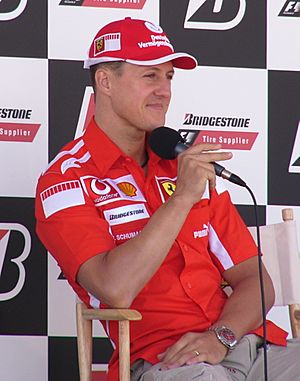
After turbo engines were banned in 1989, V10 engines became the most popular in F1. They offered the best balance of power and fuel use. By 1998, all teams used V10 engines.
In 2000, Williams started to become strong again with a new partnership with BMW. The main fight was between Häkkinen and Schumacher. Schumacher won in 2000, bringing the World Drivers' title to Ferrari for the first time since 1979. In 2001, Ferrari and Schumacher started to dominate, with Schumacher winning the championship early in the season. Electronic driver aids like automatic gearboxes and launch control were also brought back in 2001.
The 2002 season was completely dominated by Ferrari. They finished every race and won 15 out of 17. Michael Schumacher scored more points than the second and third-placed drivers combined. He won the championship earlier than anyone else in history.
While Ferrari celebrated, many felt the sport was in trouble. Two more private teams, Prost and Arrows, closed down. Benetton was bought by Renault. Ferrari's dominance and some controversial team orders in 2002 made many fans unhappy. Ratings and attendance dropped.
However, many major car manufacturers joined F1 since 2000. BMW and Honda returned in 2000. Ford rebranded the Stewart team as Jaguar and developed engines. In 2001, Renault returned as an engine maker and bought the Benetton team. Toyota joined in 2002, building both chassis and engines. Mercedes continued its involvement with McLaren.
In 2003, despite new rules to prevent Ferrari's dominance, Schumacher won the championship again. It was a much closer fight with Kimi Räikkönen and Juan Pablo Montoya. The season was exciting, with eight different race winners and five different teams winning, including Renault and Jordan.
In 2004, Ferrari and Schumacher returned to almost total dominance, winning 12 of the first 13 races. New races were added in Bahrain and China, increasing the number of races to eighteen. This expanded F1's global reach. 2004 was Michael Schumacher's seventh and final World Championship. He also held the record for most wins (91) at the time. Electronic driver aids like automatic gearboxes and launch control were banned again in 2004 to reduce costs and emphasize driver skill. Traction control was still allowed until 2008.
In 2005, Ferrari and BAR faded. The Renault team dominated early, and Fernando Alonso built a strong lead. McLaren became much stronger later in the season, winning six of seven races. However, their early reliability problems meant they couldn't catch Renault.
Alonso became F1's youngest ever champion in Brazil. Renault also secured the Constructors' title. These two teams won all but one race, the controversial 2005 United States Grand Prix, which Ferrari and Schumacher won because most other teams didn't race due to tyre issues.
The last small independent racing team, Minardi, was bought by Red Bull in 2005 and renamed Scuderia Toro Rosso. Jordan was bought by Midland and renamed Midland F1 for 2006. BMW bought a majority stake in Sauber. Honda also bought BAR. By 2006, car manufacturers had a huge presence in F1.
2005 marked the end of the V10 engine era. V10s had been mandatory since 2000 to keep costs down. Renault and Ferrari engines were very successful in this era, winning many championships.
2.4-litre V8 Engines (2006–2008)
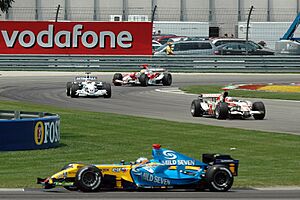
2006 was the last season with two tyre manufacturers, Bridgestone and Michelin. Michelin announced they would leave F1 at the end of 2006, making Bridgestone the sole supplier from 2007.
Renault and Fernando Alonso started 2006 strongly. Ferrari made a comeback mid-season. At the Italian Grand Prix, Schumacher reduced Alonso's lead to just two points. Schumacher also announced his retirement at the end of the season. An engine failure for Schumacher in Japan and a puncture in Brazil allowed Alonso to win his second Drivers' Championship. Renault also won the Constructors' Championship.
The 2007 season saw a much stronger McLaren, with world champion Alonso and rookie Lewis Hamilton. Hamilton surprised everyone by finishing on the podium in his first nine races, taking a big lead. Alonso's relationship with McLaren became difficult. Mistakes by Hamilton and a mechanical problem ruined his championship. Ferrari's Kimi Räikkönen won the championship after a strong second half of the season, overcoming a 17-point gap in the last two races.
McLaren finished with the same points as Hamilton and Alonso, but Ferrari won the Constructors' Championship after McLaren was disqualified due to a spying controversy. 2007 was the last season with traction control. From 2008, standard electronic control units were used, banning this technology.
2008 again saw McLaren and Ferrari with the best cars. Hamilton won the Drivers' Championship in a thrilling finish, overtaking Timo Glock on the last corner of the last lap in Brazil to secure the points he needed. Felipe Massa won the race and would have been champion if Hamilton hadn't made that overtake. Ferrari won the Constructors' Championship.
Cost-Cutting and Manufacturer Departures (2009–2013)
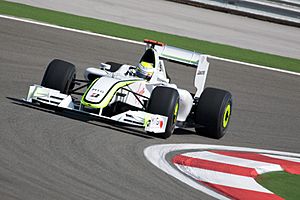
By the 2000s, F1 cars had become very complex, making racing less exciting. In 2009, many new rules were introduced to encourage overtaking, including engine RPM limits and adjustable front wings.
A significant new system was the Kinetic Energy Recovery System (KERS), which stored energy from braking to give a boost of acceleration. Due to the global economic recession, more rules were brought in to cut costs, such as reducing testing and increasing engine and gearbox lifespan.
The new rules led to a new order in 2009. New teams Brawn GP and Red Bull Racing led the way, while Ferrari and McLaren had a difficult season at first. Ferrari improved later, and McLaren's car redesign helped Lewis Hamilton win two races.
Jenson Button dominated the start of the season with Brawn GP, winning six of the first seven races. He eventually won the Drivers' Championship in Brazil, and Brawn GP won the Constructors' Championship in its only season before being bought by Mercedes. Many major car manufacturers started leaving F1 due to the economic crisis. Honda left in 2008, and Toyota and BMW left in 2009. Renault reduced its involvement, and Cosworth stopped supplying engines in 2013.
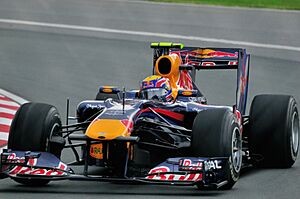
2010 brought more rule changes. KERS and double diffusers were banned, but new features like F-ducts were introduced. Drivers were limited to eight engines per season. The points system also changed significantly, awarding points to the top 10 finishers.
Red Bull Racing had a great season in 2010, thanks to designer Adrian Newey. They won the Constructors' Championship, and Sebastian Vettel won the Drivers' Championship in the final race, becoming the youngest ever World Champion. Mercedes GP (formerly Brawn GP) had a less successful season, with Michael Schumacher returning but often beaten by Nico Rosberg.
McLaren and Ferrari had better seasons in 2010. The Drivers' Championship was very close, with four drivers still in contention at the final race. Vettel won the race and the title.
After a controversial race in 2010, the ban on team orders was dropped. In 2011, KERS was reintroduced, and the Drag reduction system (DRS) was added, allowing drivers to adjust their rear wing for more speed. Pirelli became the new tyre supplier. Vettel and Red Bull dominated 2011, winning their second consecutive titles. Vettel became the youngest double world champion.
Vettel and Red Bull continued their dominance, winning both titles in 2012 and 2013. Vettel won his third consecutive title in 2012 after a close fight with Fernando Alonso. In 2013, Red Bull's car was superior, and Vettel won nine races in a row, securing his fourth consecutive Drivers' Championship.
1.6-litre Turbocharged V6 Hybrid Engines (2014–2021)
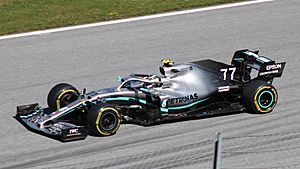
Formula One entered its second turbocharged era in 2014. All cars now use 1.6-litre single turbocharged 6-cylinder engines with a rev limit of 15,000 rpm. The minimum weight of cars was also increased. Ferrari, Mercedes, and Renault produced engines from 2014, with Honda joining in 2015.
The new turbo engines produce around 600 horsepower. But a new Energy Recovery System (ERS) is twice as powerful as the old KERS, giving drivers an extra 160 horsepower when activated. Since 2017, new rules and engine improvements have made cars faster than ever.
The Mercedes team and their drivers Lewis Hamilton and Nico Rosberg dominated the start of the hybrid era. They won 51 of 59 races between 2014 and 2016, and all championships. Hamilton was champion in 2014 and 2015, while Rosberg won in 2016. Mercedes' success came from their "split turbocharger" design, which gave them a big advantage.
Ferrari and Sebastian Vettel became strong challengers in 2017 and 2018 after new aerodynamic rules. However, Hamilton and Mercedes still won both titles comfortably. Mercedes continued to win both championships in 2019 and 2020. Hamilton equaled Michael Schumacher's record of seven World Championships.
In 2021, Mercedes faced tough competition from the Honda-powered Red Bull team. Their driver Max Verstappen won the Drivers' Championship after a season-long battle with Hamilton, ending Mercedes' winning streak in the hybrid era.
Ground Effect Cars and Aerodynamic Changes (2022–Present)
In 2022, the FIA introduced new rules to promote "closer racing." These rules focused on aerodynamics and brought back "ground effect" for the first time since 1983. In older cars, the air flowing off the car created "dirty air," which made it harder for cars to follow closely. The new 2022 cars use ground effect to create downforce, meaning less drag and dirty air behind the car. This allows cars to follow more closely, leading to more exciting overtakes.
The new design simplifies the car's exterior, using the floor to generate downforce. The front wing is designed to prevent air from being pushed outwards. Bargeboards were removed, and the rear wings are mounted higher. The number of aerodynamic upgrades teams can make was also reduced to cut costs.
While the cars still use 1.6-litre turbocharged V6 hybrid engines, they now include new sensors and standard parts for better monitoring. The fuel also changed in 2022, with 10% bio-components (E10 ethanol fuels) to make F1 more sustainable and align with road car fuel rules.
After a slow start dominated by Ferrari, Red Bull Racing took over the 2022 season. Their drivers Max Verstappen and Sergio Pérez won most races. Verstappen won the World Driver's Championship, and Red Bull won the Constructor's Championship. Verstappen set a new record for the highest number of points in one season, with 454 points.
How Car Quality and Driver Skill Matter (1950–2020)
A study by Andrew Bell, published in The Economist in 2020, looked at how much car quality matters compared to driver skill. Here's a ranking of champion drivers based on that study:
- Juan Manuel Fangio (2.9)
- Jim Clark (2.6)
- Alain Prost (2.1)
- Jackie Stewart (1.95)
- Michael Schumacher (1.9)
- Lewis Hamilton (1.8)
- Alberto Ascari (1.75)
- Ayrton Senna (1.7)
This ranking suggests that over time, the quality of the car has become more important. For example, Michael Schumacher won 5 of his 7 titles with just one car maker (Ferrari). Lewis Hamilton won all of his 7 titles with a Mercedes-Benz engine. In the 1950s, Juan Manuel Fangio won his 5 titles with four different teams: Alfa Romeo, Mercedes-Benz, Ferrari, and Maserati. This shows how adaptable drivers like Fangio were, and how much the car's performance has grown in importance.
See also
 In Spanish: Historia de Fórmula 1 para niños
In Spanish: Historia de Fórmula 1 para niños


